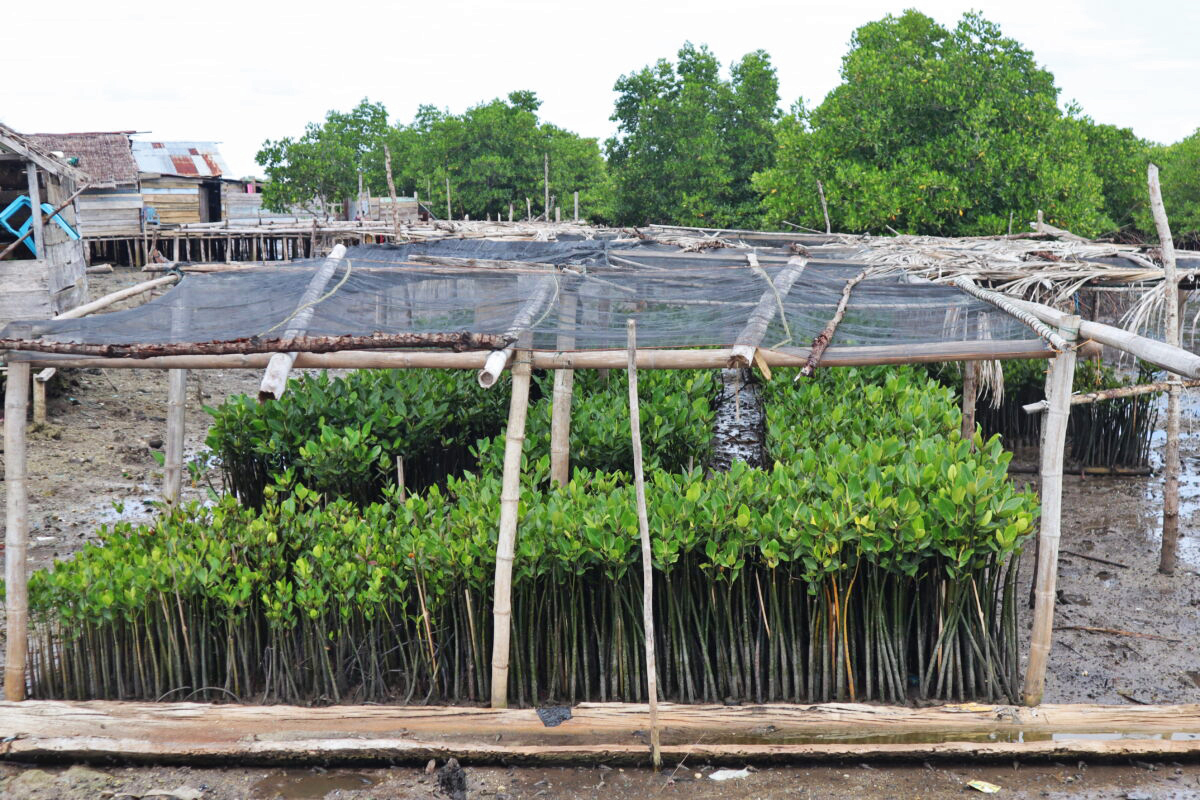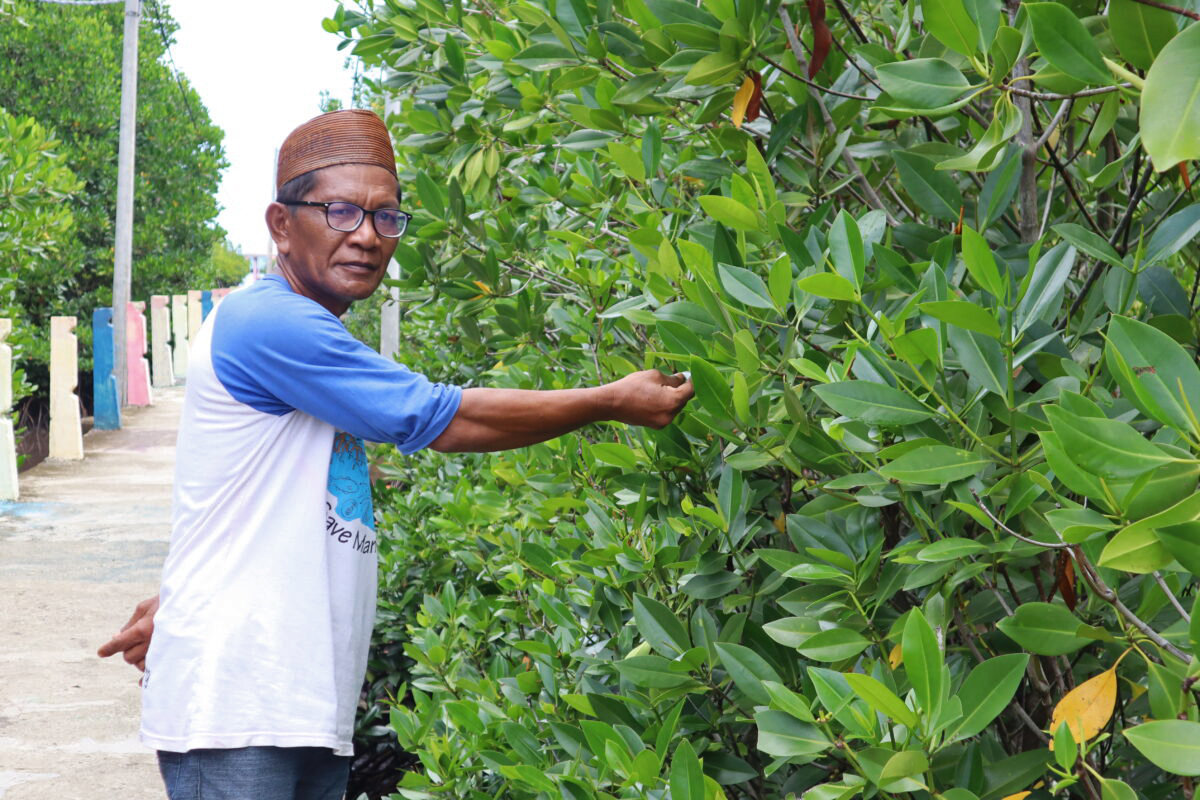- Umar Pasandre, a member of the seafaring Bajo people, has spent more than two decades protecting mangroves in Indonesia’s Gorontalo province.
- The Bajo people were first recorded by 16th-century explorers and inspired James Cameron’s sequel to “Avatar.”
- Umar leads local mangrove-replanting initiatives and has confronted those seeking to convert the forests for aquaculture production.
POHUWATO, Indonesia — The world’s largest collective of seafaring nomads has sailed the waters off Sulawesi Island and farther afield for centuries, forging a cultural legacy that inspired even James Cameron, whose 2022 blockbuster Avatar: The Way of Water was based in part on the Bajo people.
In a sleepy bay in Gorontalo province, a 54-year-old Bajo seafarer named Umar Pasandre has been quietly building a career as an influential environmental defender, protecting the natural beauty that has shaped his people’s identity.
“In the past, many of these mangrove trees were cut down as the main materials for building houses and firewood,” Umar told Mongabay Indonesia, wearing glasses and a blue-and-white “Save Mangrove” T-shirt.
“Not anymore — many people are now aware of the importance of mangroves for the environment.”
The Bajo people are a diffuse group of nomad mariners from Southeast Asia, with roots in Indonesia, Malaysia and the Philippines. Their existence was first recorded by Venetian explorer Antonio Pigafetta in the early 16th century.
In 1901, the Dutch colonial government in Sulawesi organized a settlement of Bajo seafarers into a village called Toro Siajeku, according to researchers from the Sultan Amai Gorontalo State Islamic Institute. That community is known today as Torosiaje.
In Torosiaje, the Bajo lived on bidok boats until the 1930s, when they began building over-water homes on stilts to better access the economy on land.
However, the identity of Umar and his fellow Bajo sailors remained anchored in the ocean. In 1982, the government attempted to relocate the community to farmland, but the Bajo felt like fish out of water, and soon, one by one, they returned to the water’s edge.

Mangrove restoration
Indonesia accounts for the world’s largest expanse of wetland forests, with about 3.3 million hectares (8.2 million acres) of mangroves lining river basins and shorelines like Torosiaje.
Researchers estimate around 40% of the archipelago’s mangroves have been damaged in the past 30 years as the trees were cleared for shrimp ponds, charcoal production and construction materials.
In 2020, President Joko Widodo announced ambitious plans to plant 600,000 hectares (1.5 million acres) of mangroves within five years, expanding the role of the country’s peatland agency to include restoration of mangrove forests. The government is relying on communities to pitch in on the planting.
Read more: From Flores to Papua: Meet 10 of Indonesia’s mangrove guardians
Umar has spent the past two decades quietly protecting these trees, working to gradually shift attitudes in the community and, more recently, confronting those seeking to deforest.
Around 125 hectares (309 acres) of mangroves fringe the Torosiaje bay and clutch of outlying islands 7 kilometers (4 miles) from the shore.
In 2000, Umar attended a forestry course run by the local government before joining a national land rehabilitation program known as Gerhan. He has sought to pass down that knowledge through the Bajo community ever since.

For generations, the Bajo people in Torosiaje, including Umar, used mangrove trees in the construction of their homes.
“In this area there are still people who are indifferent to the importance of preserving mangroves,” Umar said. “Thank God, the majority now know and have started to take care of them, and even nurture mangrove seedlings in their homes.”
Umar has emphasized the role of mangroves as a marine feeding ground, a clear practical benefit for a seafaring people who rely on fishing to meet their needs. He speaks of mangroves’ role as nature’s defense against coastal abrasion, storm surges and tsunamis.
“The bottom line that I convey to the community is that if the mangrove forest is damaged, it will affect the lives of fishermen,” Umar said. “And the people of the Bajo tribe whose livelihoods depend on the sea.”
In 2007, Umar started the Paddakauang Environmental Awareness Group, a collective of Bajo conservationists from three villages. He continues to lead the group’s mangrove-planting program.
“The process to grow a mangrove tree takes a long time. It can even take up to 30 years for trees to become large enough,” Umar said. “We continue to provide education to the public so they don’t cut down mangroves anymore.”

Pulling up trees
Government data show 67% of mangrove forests in Gorontalo province are considered damaged, with aquaculture ponds the predominant reason for mangrove loss.
Indonesia’s Ministry of Environment and Forestry records a total of 473,273 hectares (1.17 million acres) of forest in Pohuwato district. Of that total forest area, the government classifies 15,600 hectares (38,550 acres) as mangroves — 8,233 hectares (20,344 acres) of which have been converted into ponds for aquaculture production.
In 2010, Pohuwato district leader Syarif Mbuinga issued new rules against clearing mangroves for shrimp production, but state data on mangroves in 2018 showed the practice continued.
Umar said the demand for aquaculture was a constant threat to the remaining mangroves here. On the Torosiaje coast, Umar has come face to face with prospectors seeking to tear down the trees for industry. In 2010, a group came to Umar’s home to confront him over his refusal to allow any conversion.
Umar would scrutinize permits for irregularities and coalesced his network of supporters from the Bajo community to block any development. In response, the seafarer has faced allegations of taking money and other wrongdoing. None has taken the wind from his sail.
“If I die just for the truth of protecting the environment, that’s fine,” Umar said.
He continues to widen and expand his conservation work. He reads widely on mangrove preservation, from their role as a store of blue carbon to mangroves’ ability to protect his coastline. He has become a member of a working group on mangroves for the Gorontalo provincial government, and partnered with profit organizations like Burung Indonesia (the local affiliate of BirdLife International) and Japesda (a nature nonprofit) on conservation programs.
People in Torosiaje are seeing the results of Umar’s two decades spent pioneering mangrove conservation: after years of declines, the forest area is beginning to increase.
“Maybe until my life ends I’ll stay on this path to protect the mangrove forests on the coast of Torosiaje,” Umar said. “I’ll remain true to what I’m doing here.”
Banner image: Bajo seafarer named Umar Pasandre has been quietly building a career as an influential environmental defender. Image by Sarjan Lahay for Mongabay Indonesia.
This story was reported by Mongabay’s Indonesia team and first published here on our Indonesian site on July 14, 2023.
Indonesia’s mangrove restoration will run out of land well short of target, study warns
FEEDBACK: Use this form to send a message to the author of this post. If you want to post a public comment, you can do that at the bottom of the page.
